How To Play Rummy Card Game: A Guide To Rummy Rules
In the rummy game , the objective is to form combinations (all sequences or sequences and sets) with the 13 cards in your hand and make a valid declaration before your opponents do. You must make sequences and sets for a valid declaration to play rummy like a professional. You can make several valid declarations: 2 sequences and 2 sets, 3 sequences and 1 set, or all cards in different sequences.
According to the rules of rummy, you must make at least two sequences to have a valid declaration. Moreover, at least one of the sequences must be a pure sequence. You will lose the hand by a significant margin if you declare without a pure sequence. All the card points in your hand will be added to calculate your penalty points.
What are Rummy Rules?
The rules of the rummy game are simple and easy to learn. Let's take a closer look at the rummy card game rules and learn how to play rummy:
- Indian rummy is played between two to six players with one or two standard decks of 52 cards with jokers. Each player is dealt 13 cards to start the game.
- The remaining cards form a closed deck and are placed face down at the center of the table. The top card from the closed deck is then placed face-up on the table. It forms an open deck for players to discard their cards.
- Apart from the printed jokers in the deck, a wild joker is chosen at random at the start of the game. All other cards of the same rank in different suits also become wild jokers for the game's duration.
- Players must pick a card from the closed or open deck on each turn and discard one to the open deck.
- To win the game, players must arrange all the cards in their hands in either sequences or sequences and sets. A valid declaration requires at least two sequences, out of which one must be a pure sequence. The player who declares first with a proper hand wins the game.
What is a Sequence?
A sequence is a group of three or more consecutive cards of the same suit. There are two types of sequences: pure sequence and impure sequence.
Pure Sequence
A pure sequence is a group of three or more consecutive cards of the same suit. There are no Joker cards in a pure sequence. As per the rummy rules, making at least one pure sequence for a valid declaration is mandatory.
 Examples
Examples
Impure Sequence
An impure sequence is a sequence (3 or more cards arranged in a sequence) in which a joker(s) has replaced one or more cards.
 Examples
Examples
What is a Set?
A set is defined as three or four cards of the same rank but different suits. A set cannot have more than one card from any suit. Rummy game rules allow you to use one or more jokers to replace any other card(s) in a set.
 Examples
Examples
Importance of Jokers in Rummy
One of the most important Indian rummy rules that are taught when you play rummy is how to use jokers. Jokers play a special role in rummy and can help you win the game. There are two types of jokers used in rummy: printed and wild jokers.
Printed Joker
A printed joker has the picture of a joker printed on it. It can be used as a substitute for any missing card and form an impure sequence or a set. Let’s look at some examples.
 Examples
Examples
Wild Joker
The wild joker is picked randomly at the beginning of the game. This card, along with other cards of the same rank and different suits, becomes the wild jokers of the game. Like the printed joker, the wild joker can also substitute any missing card and helps form a sequence or a set.
For example, if 4♦ is selected as the wild joker, 4♥, 4♣ and 4♠will also be wild jokers of that game.
 Examples
Examples
Rules of Rummy For A Valid Declaration
Valid Declaration
To make a valid declaration in the game of rummy, you must arrange all 13 cards in your hand, either in sequence or in sequences and sets. Once you have arranged your cards, discard the last unwanted card into the "Finish" slot and declare your hand to finish the game. The player who makes the first valid declaration wins and receives zero points.
To make a valid declaration, you must satisfy the following three conditions:
-
Pure Sequence: In the rummy set
rules, you need one pure sequence of at least three consecutive
cards to win. Without a pure sequence, any declaration made is
considered invalid, and the player loses by a margin equivalent
to the total value of all the cards in their hand.
It is important to note that a printed joker cannot be used as a substitute for any card in a pure sequence. However, a wild joker can form a pure sequence if it is a part of the same suit. - Second Sequence: Forming at least two sequences is necessary to make a valid declaration in rummy. Along with the mandatory pure sequence, you need a second sequence, which can be either pure or impure. Players can create more than two sequences if they wish.
- Arrange all the cards in your hand that are not part of the mandatory two sequences in either sequences or sets to make a valid declaration in rummy. While forming a set or sequence is optional, all cards must be part of a valid combination.
 Examples
Examples
Invalid Declaration
A declaration is deemed invalid if it does not fulfill any of the three conditions mentioned above. Making an invalid declaration will result in an instant loss. The other players will keep playing until one of them makes a valid declaration. Below are some examples of invalid declarations.
 Examples
Examples
Points Calculations in a Rummy Game
Different Cards Value for Point Calculation
 Printed/Wild Joker: 0 points
Printed/Wild Joker: 0 points
 Numbered Cards (2,3,4,5,6,7,8,9): Face Value
Numbered Cards (2,3,4,5,6,7,8,9): Face Value
 Picture Cards (J, Q, K, A): 10 points
Picture Cards (J, Q, K, A): 10 points
Point Calculation During A Rummy Hand
 Invalid declaration: -80 points
Invalid declaration: -80 points
 First drop (Before picking your first card): -20 points
First drop (Before picking your first card): -20 points
 Middle drop (After picking your first card): -40 points
Middle drop (After picking your first card): -40 points
 3 consecutive turns missed: -40 points
3 consecutive turns missed: -40 points
 Declaring a valid hand first: 0 points
Declaring a valid hand first: 0 points
 Declaring a valid hand second: -2 points
Declaring a valid hand second: -2 points
 Examples
Examples
Player 1 and Player 2 are playing a points rummy game. According to rummy rules, Player 1 makes a valid declaration, wins the game and gets zero points.
Player 1 (Winner)

Player 2

Player 2 has created three combinations: a pure sequence, and 2 sets. He is also left with 4 ungrouped cards i.e. 2♦-3♦, Q♣-Q♥, after Player 1 has declared. So he will get a penalty of 25 points (2+3+10+10).
FAQs: How to Play Rummy
To win rummy games, a player must make sequences and sets according to various rummy rules. The player who makes a valid declaration first wins the game.
To win in a 13-card rummy game, a players must arrange all their cards in sequences and sets. A valid declaration requires at least two sequences, out of which one must be a pure sequence.
Yes, you can discard joker or any other card in the rummy card game.
A printed or wild joker is worth zero points in Indian rummy.
Yes, 2 jokers can be used to create or make a set or impure sequence in rummy.
13 cards are dealt to every player in the 2-player or 6-player rummy.
For a 2-player game, all the rummy rules are the same. The only difference is that only 1 deck is used in a 2-player rummy game.







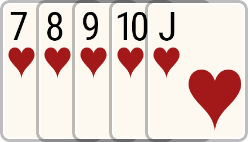



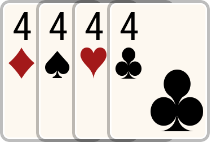
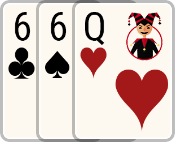
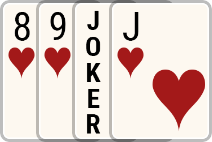

















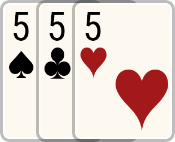



-16622018674581.png?v=1662201868)









-16909143862904.png?v=1690914386)




